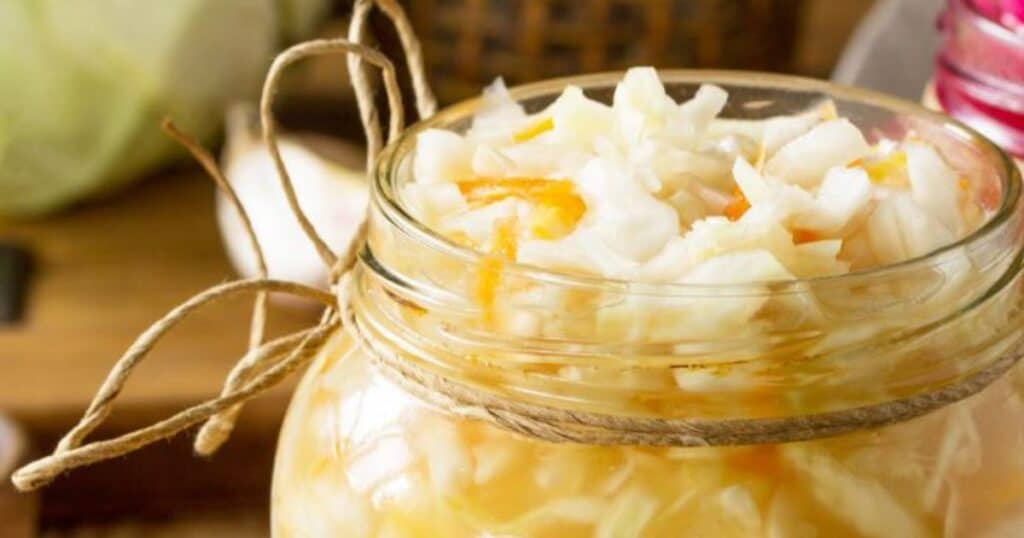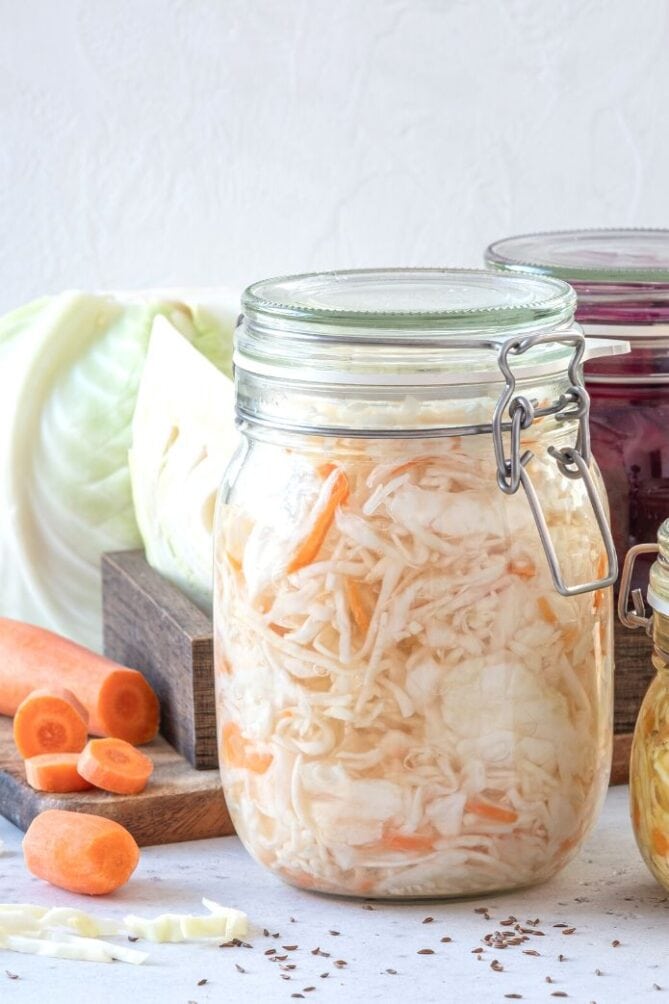Sauerkraut is a highly nutritious food that provides fiber, vitamins, minerals, enzymes, and probiotics. Learn some of the many health benefits of sauerkraut and discover how easy it is to make at home.

In this post, you’ll learn what sauerkraut is, where sauerkraut originated (spoiler alert, not Germany), the powerful health benefits of this delicious condiment, and how to make your own.
I’ve been making my own sauerkraut for over 20 years now and due to how effortlessly and flavorfully it keeps my gut healthy, I don’t leave home without it.
And, since it unlocks and elevates the flavors of any dish, I don’t eat dinner without it.
Learn why you might want to start eating sauerkraut and how easy it is to make your own sauerkraut.
Sauerkraut is a German word for sour white cabbage.
It is a popular fermented food traditionally made by mixing shredded cabbage with salt and packing the mixture into a crock or jar. It is then left to ferment at room temperature, for anywhere from one week to four weeks.
During this time, lactic acid bacteria transform the sugars in the shredded cabbage and vegetables into lactic acid, a natural preservative, and digestive aid.
That’s it. No vinegar. No preservatives.
The fermentation process gives sauerkraut its characteristic tangy flavor and increases its nutritional value by creating beneficial probiotics.
It’s a traditional ingredient in many European cuisines and has been used for centuries for its health benefits and preservation properties. Sauerkraut is a great source of vitamins and minerals, such as Vitamin C and K, and it is also high in probiotics which can aid in digestion and boost the immune system.
History of Sauerkraut

Sauerkraut originated nearly 2,000 years ago in ancient China. In summer, slaves building the Great Wall of China lived on cabbage and rice. In winter, the cabbage was preserved with rice wine, which soured the cabbage, to keep thousands of laborers healthy in the worst of conditions.
The Tartars brought sauerkraut to Europe, where the recipe was improved upon. Rather than packing cabbage with rice wine, the Europeans packed the sliced cabbage in salt to give bacteria present on the cabbage the ability to convert the natural sugars into lactic acid, thus creating what we know today as sauerkraut.
During the 18th century, explorers such as Captain Cook, relied on sauerkraut to prevent scurvy, caused by a lack of Vitamin C, during extended ocean voyages, taking as much as 25,000 pounds of the Vitamin-C-rich fermented food with them.
Health Benefits of Sauerkraut

Sauerkraut is a good source of vitamin C, vitamin K, and iron. It also contains smaller amounts of vitamin B6, folate, and potassium.
Vitamin C boosts the immune system and acts as an antioxidant. Vitamin K supports healthy bones and blood clotting. And iron is essential for making red blood cells and transporting oxygen in the body.
The high levels of probiotics found in sauerkraut, and other fermented vegetables, help to balance the gut microbiome, increasing the number of healthy bacteria in the gut and improving overall digestive function. Additionally, the lactic acid produced during the fermentation process can help to break down food in the gut, improving digestion and reducing symptoms of bloating and constipation.
The bacteria found in sauerkraut produce enzymes during the fermentation process, adding to the already high enzyme content of the dish. These enzymes aid in the digestion of food, reducing the strain on the digestive system and improving nutrient absorption.
Other fermented foods, such as kimchi, miso, pickles, yogurt, and kefir, will have many of the same health benefits.
If you’re ready to take advantage of the many health benefits of sauerkraut, don’t just run to the store and grab a can off the shelf.
Raw vs Pasteurized Sauerkraut
First, learn the difference between raw sauerkraut and pasteurized sauerkraut.
Raw—or “homemade”—sauerkraut:
Contains live probiotics, which are beneficial bacteria found in fermented foods.
Retains all of its original enzymes and nutrients, as it is not subjected to high heat during the pasteurization process.
Generally has a stronger, tangier flavor.
Is found in the fridge section of the grocery store. In order to stabilize the fermentation process and retrain nutrients, sauerkraut needs to be kept cool.
Pasteurized—or “commercial”—sauerkraut:
Does not contain live probiotics, as the heat from the pasteurization process kills off the beneficial bacteria.
Has a milder flavor, as the heat from the pasteurization process can affect the taste of the dish.
Is found in a can on grocery store shelves, as it has a longer shelf life than raw sauerkraut.
Often contains vinegar (to give sauerkraut its “tang”), Sodium Benzoate, Sodium Bisulfate (preservatives), and sugar (flavoring).
In conclusion, while both raw and pasteurized sauerkraut are healthy additions to a diet, raw sauerkraut is more nutritious due to its higher probiotic content and retention of enzymes and nutrients.
Use this Sauerkraut Shopping Guide to make sure you buy the Right Stuff or save money by making your own sauerkraut.
How to Make Sauerkraut at Home

Sauerkraut is easy to make at home. You don’t need to purchase expensive fermentation equipment. To get started, grab a head of cabbage, salt, a digital scale, and a mason jar or leftover pickle jar.
Follow my quick overview below, but be sure to visit my SureFire Sauerkraut Method: The Complete Guide, a mini fermentation course in which I teach you everything you need to know including proven tips, step-by-step photos, and helpful notes.
This recipe includes grated carrots and minced garlic. Feel free to get creative and add seasonings of your choosing (caraway seeds, juniper berries, minced onion, jalapeno peppers) as shown in my sauerkraut recipe set.
Equipment:
Digital scale
Quart (liter) canning jar with lid
Large mixing bowl
Sharp knife, grater, measuring spoons
Ingredients:
1 large head of green cabbage
Salt
Grated carrot
Minced garlic
Instructions:
Grate 200 grams of carrots into a large mixing bowl.
Add 2-3 cloves of minced garlic.
Shred 600 grams of fresh cabbage into thin strips and place in the bowl along with the carrots and garlic.
Add 1 tsp (16 grams) of salt and mix well.
Leave to sit for 20 minutes. This gives time for the salt to pull the water out of the cabbage cells.
Massage the mixture until you see a small puddle of brine at the bottom of your bowl.
Pack the cabbage mixture into the mason jar, pressing down on it firmly.
Ensure that the liquid covers the cabbage entirely, leaving at least 1 inch of headspace in the jar. Use a fermentation weight to hold everything below the brine. I like to use a small jelly jar or shot glass jars.
Place the lid on the jar and store it in a place away from direct sunlight for at least 7 days. The ideal fermentation temperature is 60° F (16° C) to 70° F (21° C).
Check the jar daily and remove any scum or mold that forms on the surface.
Sauerkraut fermentation takes 7-28 days. When the taste and texture are to your liking, transfer it to the refrigerator for storage.
Note: The length of time for the sauerkraut to ferment will vary depending on the fermentation temperature. You can taste the sauerkraut every few days to determine if it is ready.
Ways to Eat Sauerkraut

The texture and flavors of sauerkraut go well with any dish. Below are some simple ways to eat sauerkraut with more in this popular post: 33 Easy Ways to Eat Sauerkraut That Will Have You Craving More
Alongside any meal. A forkful or two of sauerkraut will bring out the flavors and aid in digestion, especially protein, and fats.
On a sandwich or hot dog. Sauerkraut adds a tangy, crunchy texture to sandwiches and hot dogs.
In a salad. Fermented cabbage can be added to salads for a tangy, crunchy contrast to the greens.
To enjoy the beneficial enzymes and probiotics in sauerkraut, don’t heat it. Instead, add after your dish is cooked.
Frequently Asked Questions
Is sauerkraut good for you to eat?
Sauerkraut is a super-healthy food high in fiber, vitamins, minerals, and probiotics to improve gut health and boost the immune system.
What does sauerkraut taste like?
Sauerkraut has a tangy, sour, and slightly salty flavor due to the fermentation process it undergoes. Depending upon fermentation temperature and duration the texture varies from slightly crunchy to soft and chewy. The flavor of sauerkraut can vary depending on the variety of vegetables and seasoning mixed in with the cabbage.
What is sauerkraut made from?
Many make sauerkraut with just cabbage and salt. For variety, I like to add “flavoring” vegetables (carrots, beets, onions, hot peppers, etc.) and spices (caraway, juniper berry, fennel seeds, cumin seeds, Korean red pepper, etc.) as seen in my book Fermentation Made Easy! Mouthwatering Sauerkraut.
How much sauerkraut to eat each day?
Think of sauerkraut as a condiment. Just a few forkfuls consumed 1-2 times daily deliver enough probiotics to help build a healthy gut microbiome.
The Bottom Line: Why Sauerkraut?
It takes just…
One jar at a time.
One bite at a time.
To slowly improve the health of your gut which in turn will gradually transform your overall health.
Be a part of bringing back this ancient method of preservation that retains the vitamins, minerals, enzymes, and probiotics necessary for the health you deserve.
Your tastebuds will thank you.
Your belly will thank you.
The friends and family you share your delicious fermented foods with will thank you.




 This post may contain affiliate links which won’t change your price but will share some commission.
This post may contain affiliate links which won’t change your price but will share some commission.




